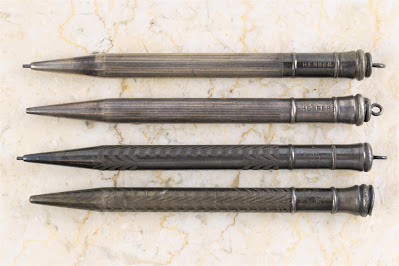This article has been included in The Leadhead's Pencil Blog Volume 7, now available here.
If you don't want the book but you enjoy the article, please consider supporting the Blog project here.
A recent online auction brought the top pencil in this pair to my doorstep:
Both are Autopoints, specially marked for the Chicago “Century of Progress” Exhibition of 1933-1934. As soon as it arrived, I couldn’t wait to take this picture and send it to my friend and loyal knight Irvine Nichols, from Stratford, Ontario. Irvine was kind enough to part with the lower example so that I could include it in A Century of Autopoint (see page 113). Irvine has been an ardent fan of the blog from the very beginning; in fact, to commemorate Volume 6, he sent me this picture last September, posing with his copy of the book in front of Stratford City Hall.
I emailed Irvine the picture of the two Autopoints, but the response wasn’t what I expected: Irvine’s wife replied to my email to report that Irvine has passed away. I was privileged to have known him.
I’m glad I had finally gotten around to fulfilling his longstanding request for an article on the history of The Henber Company, Irvine’s pet project (see “Mea Culpa,” Volume 6, page 27). I just wish Irvine were still around to see the wrinkles in the Henber story that have turned up since.
I’ll start with a taxonomy of the “normal” Henbers. Most are sterling, and they come in full-length models, with or without clips:
And short ringtop models, with or without rings:
There’s two styles of imprints on these: a vertical, block print imprint and more commonly, an italic imprint:
As mentioned in that previous article, an unusual style element on the sterling Henber pencils is the machining on the barrel, which usually extends down closer to the tip. Most metal pencils of the era don’t have machining below the part where the barrel begins to taper down to the point:
Less frequently, the Henber is found in gold fill. All the ones I have found have hexagonal barrels:
Until recently, I thought all of these had the italic imprint:
Then this one turned up in an auction last fall:
A few advertisements I turned up for that last article illustrate Henber pencils, and all of them show pencils similar to these. However, they don’t provide enough detail to substantiate which imprints came first.
Until recently, this was my known universe of the Henber; Irvine and I often compared notes, and if Irvine knew more about the brand than what I've shown, he didn't tell me about it. None of the research either of us did explains the things I’ll be showing you over the next three days . . .











No comments:
Post a Comment